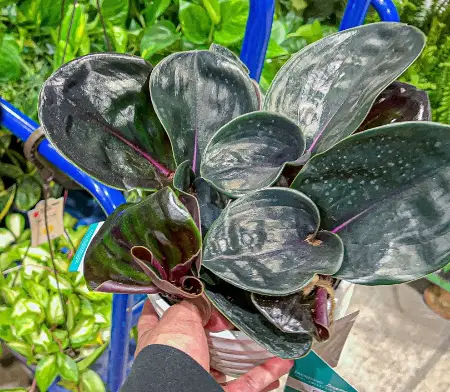Looking to add a touch of elegance to your indoor garden? Look no further than the geogenanthus ciliatus plant. With its vibrant green leaves and unique texture, this stunning plant is sure to catch your eye and bring a breath of fresh air into your home. But what makes the geogenanthus ciliatus truly special?
Well, it thrives in low light conditions, making it the perfect choice for those with less-than-sunny spaces. Whether you’re a plant enthusiast or just starting your green thumb journey, this captivating plant is worth considering for your collection. Let’s dive in and explore the wonders of the geogenanthus ciliatus!
Exploring the Geogenanthus Ciliatus Plant: A Guide to its Care and Maintenance
The Geogenanthus Ciliatus, commonly known as the Geogenanthus plant, is a stunning tropical plant that belongs to the family of Marantaceae. Originating from South America, specifically Brazil and Argentina, this plant has captured the hearts of many indoor plant enthusiasts due to its unique features and vibrant foliage.
In this comprehensive guide, we will delve into the world of the Geogenanthus Ciliatus plant, exploring its characteristics, care requirements, propagation methods, and more. Whether you are a seasoned plant enthusiast or a beginner looking to add a touch of tropical beauty to your home, this article will provide you with all the information you need to successfully cultivate and nurture this stunning plant.
About the Geogenanthus Ciliatus Plant
The Geogenanthus Ciliatus plant is renowned for its beautiful foliage, which features intricate patterns and vibrant colors. Its leaves are broad, oval-shaped, and display a deep green coloration. What sets this plant apart from others is the stunning silver veins that run across the leaves, creating an eye-catching contrast. Additionally, the undersides of the leaves have a purple hue, adding another layer of visual appeal.
One of the standout characteristics of the Geogenanthus Ciliatus plant is its ability to change the position of its leaves throughout the day. This phenomenon, known as nyctinasty, causes the leaves to move in response to the lighting conditions. The leaves will open up and orient themselves towards the light during the day, and then fold back at night, giving the plant an ever-evolving appearance.
Light Requirements
Providing the right amount of light is crucial for the health and growth of the Geogenanthus Ciliatus plant. While it thrives in bright, indirect light, it is important to avoid exposing the plant to direct sunlight, as it can scorch the delicate foliage.
Place your Geogenanthus plant near a window with filtered light or provide it with bright, indirect artificial lighting if natural light is limited.
Temperature and Humidity
The Geogenanthus Ciliatus plant thrives in warm and humid environments, mimicking its native habitat in South America. Ideally, maintain a temperature range of 65-85°F (18-29°C) to ensure optimal growth. Avoid placing the plant in areas with cold drafts or sudden temperature fluctuations, as it can negatively impact its health.
In terms of humidity, the Geogenanthus Ciliatus plant prefers high levels of moisture. Consider placing the plant in a bathroom or near a humidifier to provide the necessary humidity levels. If the air in your home tends to be dry, you can regularly mist the leaves or use a pebble tray filled with water to increase humidity around the plant.
Watering
Proper watering is crucial for maintaining the health and vitality of the Geogenanthus Ciliatus plant. As a general rule, it is important to keep the soil consistently moist, but not waterlogged. Overwatering can lead to root rot, while underwatering can cause the leaves to wilt and dry out.
To water your Geogenanthus plant, thoroughly saturate the soil and allow any excess water to drain. Check the moisture level of the soil regularly, and water only when the top inch of the soil feels slightly dry. Adjust the watering frequency based on the environmental conditions, such as temperature and humidity levels.
Tip: Using filtered or distilled water is beneficial for the Geogenanthus Ciliatus plant, as it is sensitive to chemicals found in tap water.
Soil Requirements
The Geogenanthus Ciliatus plant thrives in well-draining soil that retains moisture while allowing excess water to drain away. A recommended soil mix for this plant consists of equal parts peat moss, perlite, and quality potting soil. This mixture provides a balanced environment for the roots, promoting healthy growth and preventing waterlogged conditions.
Tip: Adding organic matter, such as compost or leaf mold, to the soil mixture can enhance its fertility and nutrient content, benefiting the overall health of the Geogenanthus Ciliatus plant.
Read More: About How Long Does Terrarium Last?
Fertilization
To support the growth and development of the Geogenanthus Ciliatus plant, regular fertilization is essential. During the growing season, which typically spans from spring to summer, use a balanced, water-soluble fertilizer with a formulation of 10-10-10 or 20-20-20. Dilute the fertilizer to half the recommended strength and apply it every two to four weeks.
Reduce fertilization during the dormant period in fall and winter.
Propagation Methods
There are several methods for propagating the Geogenanthus Ciliatus plant, including division, stem cuttings, and seed propagation. Let’s explore each of these methods in detail:
1. Division:
2. Stem Cuttings:
3. Seed Propagation:
Common Pests and Diseases
While the Geogenanthus Ciliatus plant is relatively resistant to pests, certain conditions can make it vulnerable to attacks. Here are some common pests and diseases to be aware of:
1. Spider Mites:
2. Mealybugs:
3. Leaf Spot:
The Geogenanthus Ciliatus plant is a remarkable tropical plant that can bring a touch of exotic beauty to any indoor space. With its vibrant foliage, unique leaf movements, and relatively low-maintenance requirements, it is an excellent choice for both experienced plant enthusiasts and beginners.
By providing the right conditions, including appropriate light, temperature, humidity, and proper watering, you can enjoy the beauty and vitality of this stunning plant. Experiment with different propagation methods and watch as your Geogenanthus Ciliatus plant thrives and flourishes in your care.
Read More: About How To Clean Moss For Terrarium
Frequently Asked Questions (FAQs)
The Geogenanthus ciliatus plant thrives in a warm and humid environment. It prefers temperatures between 65°F and 85°F (18°C and 29°C) and requires high humidity levels of around 60% to 80%. Keep the plant away from drafts and direct sunlight.
It is recommended to keep the soil of your Geogenanthus ciliatus plant consistently moist. Water it thoroughly when the top inch of soil feels dry. Ensure proper drainage and avoid overwatering, as it can lead to root rot.
Geogenanthus ciliatus plants benefit from regular fertilization during the growing season. Use a balanced, water-soluble fertilizer once every two weeks. Dilute the fertilizer according to the package instructions to prevent overfeeding.
Propagation of Geogenanthus ciliatus plants can be done through division or stem cuttings. To divide the plant, carefully remove it from its pot and separate the clumps. For stem cuttings, choose healthy stems and place them in a suitable rooting medium until they develop roots.
Geogenanthus ciliatus plants are prone to common houseplant pests such as aphids, mealybugs, and spider mites. Regularly inspect the plant for any signs of infestation, such as discolored leaves or webbing, and treat them with appropriate organic or chemical remedies.
To increase humidity levels around your Geogenanthus ciliatus plant, you can use a humidifier, place a tray of water nearby, or mist the leaves with water regularly. Avoid misting directly on the flowers or buds to prevent damage or rotting.
Geogenanthus ciliatus plants prefer bright, indirect light, but they can tolerate lower light conditions. However, too little light may result in leggy growth or limited flowering. Consider using artificial grow lights to supplement natural light if necessary.
Geogenanthus ciliatus plants generally appreciate being slightly root-bound, so repotting is not required frequently. Repot the plant every 2-3 years or when you notice that it has outgrown its current pot. Use a well-draining potting mix and provide a slightly larger pot to allow for future growth.
Final Thoughts
The geogenanthus ciliatus plant is a stunning addition to any indoor garden. With its vibrant green leaves and unique ciliate texture, it brings a touch of elegance and beauty to any space. This plant is not only visually appealing but also relatively low maintenance, making it suitable for both experienced and beginner plant enthusiasts.
Its hardiness and adaptability allow it to thrive in various light conditions, including low-light environments. Whether placed on a shelf, desk, or hanging basket, the geogenanthus ciliatus plant is sure to captivate and enhance any room’s ambiance.
Auto Amazon Links: No products found.
Perfect Plants Christmas Tree Saver 8oz. | Easy Use Xmas Tree Preserver Food | Have Healthy Green Christmas Trees All Holiday Season
$9.97 (as of December 7, 2025 00:54 GMT +00:00 - More info- Product prices and availability are accurate as of the date/time indicated and are subject to change. Any price and availability information displayed on [relevant Amazon Site(s), as applicable] at the time of purchase will apply to the purchase of this product.
Kaiedos Christmas Tree Watering Funnel - 39 Inch Funnel, Reusable Design, Makes Watering Your Live Tree a Snap!
$14.99 (as of December 7, 2025 00:54 GMT +00:00 - More info- Product prices and availability are accurate as of the date/time indicated and are subject to change. Any price and availability information displayed on [relevant Amazon Site(s), as applicable] at the time of purchase will apply to the purchase of this product.
Forest Fresh Christmas Tree Preservative Tablets – Tree Water Additive for Live Fresh-Cut Trees – Keeps Trees Hydrated and Reduces Needle Drop – Non-Toxic, Made in USA – 1 Packet (8 Tablets)
$5.99 (as of December 7, 2025 00:54 GMT +00:00 - More info- Product prices and availability are accurate as of the date/time indicated and are subject to change. Any price and availability information displayed on [relevant Amazon Site(s), as applicable] at the time of purchase will apply to the purchase of this product.
Wilt-Pruf® Christmas Tree/Cutting Preserver Spray |Preserves Christmas Trees, Wreaths, Garlands, Cuttings and Carved Pumpkins | Reduces Needle Drop | Keeps Cut Trees Fresh Longer | Natural (32 oz)
$21.99 (as of December 7, 2025 00:54 GMT +00:00 - More info- Product prices and availability are accurate as of the date/time indicated and are subject to change. Any price and availability information displayed on [relevant Amazon Site(s), as applicable] at the time of purchase will apply to the purchase of this product.
Christmas Tree Watering Funnel-39 Inch Adjustable 3-Section Long Funnel Spout Funnel Watering System Xmas Plant Watering Tool for Large Indoor Outdoor Plants
$14.59 (as of December 7, 2025 00:54 GMT +00:00 - More info- Product prices and availability are accurate as of the date/time indicated and are subject to change. Any price and availability information displayed on [relevant Amazon Site(s), as applicable] at the time of purchase will apply to the purchase of this product.
Snow Joe Premium Enviro Blend Ice Melt, Green-Coated Deicer Crystals, 50 lb - Safer Melter for Vegetation, Concrete & Metals w/ Anti-Corrosion Calcium Magnesium Acetate
$32.97 (as of December 7, 2025 17:09 GMT +00:00 - More info- Product prices and availability are accurate as of the date/time indicated and are subject to change. Any price and availability information displayed on [relevant Amazon Site(s), as applicable] at the time of purchase will apply to the purchase of this product.
Muddy Mat® Shown on TV Super Absorbent Microfiber Dog Door Mat for Muddy Paws, Non-Slip Washable Pet Rug, Quick Dry Chenille Entryway Carpet, Machine Washable Indoor Outdoor mat, Grey 30"x19"
$19.95 (as of December 7, 2025 17:09 GMT +00:00 - More info- Product prices and availability are accurate as of the date/time indicated and are subject to change. Any price and availability information displayed on [relevant Amazon Site(s), as applicable] at the time of purchase will apply to the purchase of this product.
Zevo Flying Insect Trap Official Refill Cartridges - Fits Both Zevo Trap & MAX Indoor Fly Trap - Authentic Trap+Lock Technology to Catch Gnats, House & Fruit Flys (4 Official Refill Cartridges)
$14.97 (as of December 7, 2025 17:09 GMT +00:00 - More info- Product prices and availability are accurate as of the date/time indicated and are subject to change. Any price and availability information displayed on [relevant Amazon Site(s), as applicable] at the time of purchase will apply to the purchase of this product.
OLANLY Dog Door Mat for Muddy Paws 30x20, Absorbs Moisture and Dirt, Absorbent Non-Slip Washable Doormat, Quick Dry Chenille Mud Mat for Dogs, Entry Indoor Entryway Carpet for Inside Floor, Grey
$9.99 (as of December 7, 2025 17:09 GMT +00:00 - More info- Product prices and availability are accurate as of the date/time indicated and are subject to change. Any price and availability information displayed on [relevant Amazon Site(s), as applicable] at the time of purchase will apply to the purchase of this product.
ThermoPro TP50 Digital Hygrometer Indoor Thermometer Room Thermometer and Humidity Gauge with Temperature Humidity Monitor
$11.99 (as of December 7, 2025 17:09 GMT +00:00 - More info- Product prices and availability are accurate as of the date/time indicated and are subject to change. Any price and availability information displayed on [relevant Amazon Site(s), as applicable] at the time of purchase will apply to the purchase of this product.











